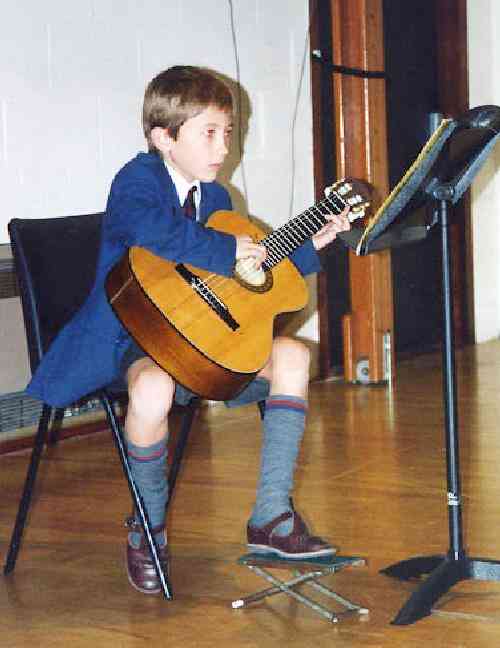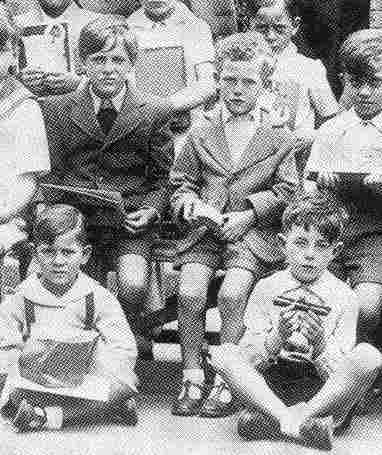School Sandals: Country Trends
|
The school sandal was most popular in England, but was worn in many other countries as well. American boys did not wear school sandals. Most boys considered them a girl's shoe style. HBC has no informnation on Belgium at this time and beliece that they mostly followed French trends. School sandals were more popular in England than any county. I think sandals actually were initially an English style, although I can not
yet substantiate this with any certainty. I first note them in the 1920s, but have no real details on when they originated. The traditional style with a narrow center strap were commonly worn by English boys from the 1920s through the 1960s. At first they were not school wear, but casual footwear. The conventions for wearing sandals changed significantly over time. Sandals in France had more of an association of warm weather holiday wear, rather than schoolwear as in England. They were common at schools, however, in the warmer weather. They were widely wiorn by the 1920s and did not begin declining in poularity until the 1950s. The mostvpopular style was the English style school sandal. German boys wore school sandals in the 1920s, but they declined in popularity during the 1930s, except for the very youngest boys. Apparentlty the NAZIs did not consider them very manly. Sandals emerged after World War II (1939-45), but primarily closed toe styles. Most Hungarian boys by the 196-s appear to have worn lace-up shoes, but a few boys wore sandals to school, closed-toe sandals that looked rather like English school sandals. HBC is unsure just how common they were and if sandals were more common in earlier years. Irish school boys like their English counterparts wore school sandals. They were the same style as worn in England. I do not think they were as popular in Ireland as in England. Sandals were commonly worn by Italian boys. I am not sure, however, how common they were for school wear. Boys at New Zealand schools also wore sandals like English boys. Locally made sandals, however, have a rougher look than the classic brands like English Clark's school sandals. Sandals were worn in Scotland, but they were never as popular as in England.
America
American boys did not wear school sandals. We notice strap shoes in the 19th century, but mostly worn by girls. An example is the Onarga School in 1882. We notice very few examples in the photographic record of American boys wearing "T"-strap school sandals. This of course was only one type of school closed-toe sandals. We do notice American boys wearing closed-toe sandals, but almost always it was the double-bar type. We have no idea why the style so popular in Britain was never much worn in America.
We notice double-bar sandals being sold in the early 20th century. They were marketed as "barefoot sandals". We notice some boys wearing them in the early 20th century and to a lesser extent the mid-20th century, but do not notice them being commonly worn to school. Most American boys considered them a girl's shoe style. They may have been worn by younger boys from affluent families to private schools, but even this this was not very common.
Belgium
HBC has no informnation on Belgium at this time and beliece that they mostly followed French trends.
England
School sandals were more popular in England than any county. I think
sandals actually were initially an English style, although I can not
yet substantiate this with any certainty. I first note them in the 1920s, but have no real details on when they originated. The traditional style with a narrow center strap were commonly worn by English boys from the 1920s through the 1960s. At first they were not school wear, but casual footwear. The conventions for wearing sandals changed significantly over time. By the 1960s only small boys were wearing closed-toe sandals outside of school. Styles also negabn to change with boys increasingly wearing a new style with a wide center strap. The style with the narrow center strap, however, continued to be worn by girls.
France
Sandals in France had more of an association of warm weather holiday wear, rather than schoolwear as in England. They were common at schools, however, in the warmer weather. They were widely wiorn by the 1920s and did not begin declining in poularity until the 1950s. The mostvpopular style was the English style school sandal.
Germany
German boys wore school sandals in the 1920s. We see the single-bar style most xommonly, but we note the "T"-strap school sandal as well. They declined in popularity during the 1930s, except for the very youngest boys. Apparentlty the NAZIs did not consider them very manly. Sandals emerged after World War II (1939-45), but primarily closed toe styles.
Hungary
Most Hungarian boys by the 196-s appear to have worn lace-up shoes, but a few boys wore sandals to school, closed-toe sandals that looked rather like English school sandals. HBC is unsure just how common they were and if sandals were more common in earlier years.
Ireland
Irish school boys like their English counterparts wore school sandals. They were the same style as worn in England. I do not think they were as popular in Ireland as in England.
Italy
We notice many Italian children wearing sandals to school. In fact we see a wide range of footwear, including diffent kinds of shoes. Many children came to school barefoot as well. Sandals were commonly worn by Italian boys and as there were no uniforms, the sandals at school were largely a relection of the footwear woirn at home. We notice different kinds of sandals. There was no one style as in England that were particulsarly common. We notice both closed and open toe types. There were several different styles of both. In public primary schools there were no uniforms, unless smocks were considered a uniform. But there were no rules about no rules about footwear. So it was up to the family. Family convetions also generally determined wether or not socks were worn with sandals. Private schools might have rules, but they were often not strict. We note the children wearing sandals both with and without socks. Both boys and girls wore sandals. Many styles were worn by both boys and girls.
New Zealand
Boys at New Zealand schools also wore sandals like English boys. Locally made sandals, however, have a rougher look than the classic brands like English Clark's school sandals.
Scotland
Sandals were worn in Scotland, but they were never as popular as in England.
HBC-SU
Navigate the Boys' Historical Clothing Web Site:
[Return to the Main school sandal page]
[Introduction]
[Activities]
[Biographies]
[Chronology]
[Clothing styles]
[Countries]
[Bibliographies]
[Contributions]
[FAQs]
[Glossary]
[Images]
[Links]
[Registration]
[Tools]
[Boys' Clothing Home]
Created: November 5, 2003
Last updated: 2:14 AM 7/9/2009




